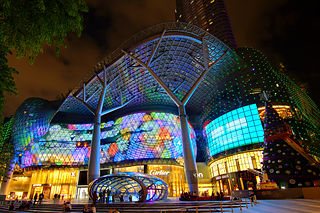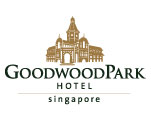
Orchard Road, often known colloquially as simply Orchard, is a major 2.5 km (1.6 mi)–long road in the Central Area of Singapore. Known as a famous tourist attraction, it is an upscale shopping area of Singapore, with numerous internationally renowned department stores, restaurants and coffeehouses located in its vicinity.

Raffles Place is the centre of the Financial District of Singapore and is located south of the mouth of the Singapore River. It was first planned and developed in the 1820s as Commercial Square to serve as the hub of the commercial zone of Singapore in Raffles Town Plan. It was renamed Raffles Place in 1858 and is now the site of a number of major banks. It is located in the Downtown Core within the Central Area, and features some of the tallest buildings and landmarks of the country.

The Central Area, also called the City Area, and informally The City, is the main commercial city centre of Singapore. Located in the south-eastern part of the Central Region, the Central Area consists of eleven constituent planning areas: the Downtown Core, Marina East, Marina South, the Museum Planning Area, Newton, Orchard, Outram, River Valley, Rochor, the Singapore River and Straits View, as defined by the Urban Redevelopment Authority. The term Central Business District (CBD) has also been used to describe most of the Central Area as well, although its boundaries lie within the Downtown Core.

Sri Temasek is a two-storey detached house built in 1869 which is sited within the grounds of the Istana in Singapore. During the island's colonial era, it served as the residence of the Chief Secretary. Since Singapore gained self-governance from the United Kingdom in 1959, the house has been the official residence of the Prime Minister of Singapore, though none of the prime ministers have ever lived there. Together with the Istana, it was gazetted a national monument on 14 February 1992.

Fort Canning Hill, formerly Government Hill, Singapore Hill and Bukit Larangan, or simply known as Fort Canning, is a prominent hill, about 48 metres (157 ft) high, in the southeast portion of Singapore, within the Central Area that forms Singapore's central business district.

The Arts House is a multi-disciplinary arts venue in Singapore. The venue plays host to art exhibitions and concerts. Built in 1827, the Old Parliament House is the oldest government building and perhaps the oldest surviving building in Singapore. The building was home to the Parliament of Singapore from 1965 to 1999, when it moved to an adjacent new building.

Shenton Way is a major trunk road serving Singapore's Central Area and is most commonly known for the commercial skyscrapers flanking both sides of the road. The road is a one-way street that starts at the junction of Boon Tat Street, Raffles Quay and Commerce Street before ending at Keppel Road.

CHIJMES is a historic building complex in Singapore, which began life as a Catholic convent known as the Convent of the Holy Infant Jesus (CHIJ). The complex is located at Victoria Street in the Downtown Core, within the Central Area, Singapore's central business district.

George Drumgoole Coleman, also known as George Drumgold Coleman, was an Irish civil architect who played an instrumental role in the design and construction of much of the civil infrastructure in early Singapore, after it was founded by Sir Stamford Raffles in 1819. Only a few of his buildings have survived in Singapore, most notably Armenian Church of Saint Gregory the Illuminator, Maxwell's House, and Caldwell House.

The Goodwood Park Hotel is a heritage hotel in Singapore, situated in a 6-hectare landscaped garden on Scotts Road. It was first built as the club house for the Teutonic Club serving the expatriate German community in Singapore, and later converted into a hotel.

Bras Basah Road is a one-way road in Singapore in the planning areas of Museum and Downtown Core. The road starts at the junction of Orchard Road and Handy Road, at the ERP gantry towards the Central Business District, and ends at the junction with Nicoll Highway, beyond which it becomes Raffles Boulevard. Several landmarks including Fairmont Singapore, Raffles Hotel, Singapore Art Museum, Cathedral of the Good Shepherd and the Singapore Management University are located along the road. A MRT station with the same name, Bras Basah MRT station, is on the Circle Line.

Balestier is a sub zone located in the planning area of Novena in the Central Region of Singapore. The main road, Balestier Road, links Thomson Road to Serangoon Road and the road continues on as Lavender Street. The area is home to rows of shophouses, such as the Sim Kwong Ho shophouses, the Balestier Art Deco shophouses, 412-418 Balestier Road, and 601-639 Balestier Road, low-rise apartments and commercial buildings as well as a shopping mall known as Shaw Plaza. However, Shaw Plaza has since closed down and is under construction. Balestier also has another mall, Zhongshan Mall. There are several lighting and electrical shops along Balestier Road, which is also home to the Ceylon Sports Club and the Indian Association. The area is known for its food such as bak kut teh and chicken rice. In the area, there are several apartments, condominiums, and budget hotels.

The Fullerton Hotel Singapore is a five-star luxury hotel located near the mouth of the Singapore River, in the Downtown Core of the Central Area, Singapore. It was originally known as the Fullerton Building, and also as the General Post Office Building. The address is 1 Fullerton Square. The Fullerton Building was named after Robert Fullerton, the first Governor of the Straits Settlements (1826–1829). Commissioned in 1924 as part of the British colony's centennial celebrations, the building was designed as an office building by Major P.H. Keys of Keys & Dowdeswell, a Shanghai firm of architects, which won the project through an architectural design competition. The architectural firm also designed the Capitol Theatre, its adjoined Capitol Building and the Singapore General Hospital. In 2015, it is gazetted as a national monument of Singapore.
Swan & Maclaren Architects is a Singaporean architectural and industrial design firm. One of the oldest architectural firms in the country, it was formerly known as Swan & Maclaren and Swan & Lermit, and was one of the most prominent architectural firms in Singapore when it was a crown colony during the early 20th century. The firm has designed numerous iconic heritage buildings in Singapore as well as Malaysia.

Stamford House is a historic building located at the corner of the junction of Stamford Road and Hill Street, in the Downtown Core of Singapore. Originally known as Oranje Building, it formerly housed a shopping mall. The building had since redeveloped along with adjoined Capitol Building and both were reopened as a hotel The Capitol Kempinski Hotel Singapore in October 2018.

Yue Hwa Building is a historic building located at the junction of Eu Tong Sen Street and Upper Cross Street in Chinatown, Singapore, next to Chinatown MRT station. Built by Swan and Maclaren in 1927, it was then the tallest building in Chinatown and was known as Nam Tin Building (南天大厦), owned by Lum Chang Holdings. The building housed the six-storey Great Southern Hotel, along with a few shops and cabarets that were popular among Chinese travellers. In 1993, Lum Chang Holdings sold the building to Hong Kong businessman Yu Kwok Chun, who converted it to the first Yue Hwa Chinese Products department store in Singapore in 1994. The renovation process, which conserved the exterior while adding features such as an atrium and waterfall to the interior, won the building the Architectural Heritage Award by the Urban Redevelopment Authority in 1997.

Caldwell House was a historical building designed and built by George Drumgoole Coleman from 1840 to 1841 in Singapore. It was the oldest building of the CHIJMES complex since 1854. It currently serves as a venue known as the Alcove at Caldwell House for wedding functions.
The Pavilion is a house on Oxley Hill, near Orchard Road in Singapore. The Pavilion served as Government House between 1859 and 1861, after Raffles House was demolished to make way for a fort. The street address of the site is 5 Oxley Rise, Singapore. The Pavilion's prominent site on the top of the hill allows it to overlook Lee Kuan Yew's house at 38 Oxley Road.
The Shell House, later known as the Singapore Rubber House, or simply Rubber House, was a skyscraper in Collyer Quay, Singapore. It was officially opened in 1960 as the Singapore headquarters of Shell plc. At the time of the building's completion, it was the fourth tallest building in Singapore, rising over 190 ft above ground level.
Gaston Dutronquoy was a French hotelier, entrepreneur and photographer. He was active in Singapore from 1839 to the early 1850s. He was the first recorded resident photographer on the island.
















